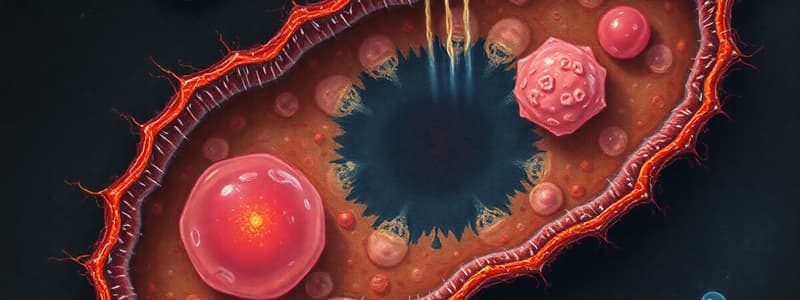Podcast
Questions and Answers
What is one primary function of the cell membrane?
What is one primary function of the cell membrane?
- To completely isolate the cell from its environment
- To store nutrients within the cell
- To allow all substances to enter the cell freely
- To act as a barrier to keep constituents in and unwanted substances out (correct)
What property do phospholipids in the cell membrane possess?
What property do phospholipids in the cell membrane possess?
- They are amphipathic, with a polar and nonpolar end (correct)
- They are exclusively hydrophobic
- They are only found in the nucleus
- They form rigid structures within the membrane
How does cholesterol affect the cell membrane?
How does cholesterol affect the cell membrane?
- It disrupts the membrane's structural integrity
- It decreases the lipid bilayer's permeability
- It enhances the permeability-barrier properties of the lipid bilayer (correct)
- It serves as a channel for ion transport
What is the intracellular space within a cell called?
What is the intracellular space within a cell called?
What role does the cytoskeleton play regarding the cell membrane?
What role does the cytoskeleton play regarding the cell membrane?
What is considered the smallest unit of life that can perform all necessary functions for living organisms?
What is considered the smallest unit of life that can perform all necessary functions for living organisms?
Which of the following structures is responsible for controlling the movement of substances into and out of the cell?
Which of the following structures is responsible for controlling the movement of substances into and out of the cell?
What distinguishes eukaryotic cells from prokaryotic cells?
What distinguishes eukaryotic cells from prokaryotic cells?
Which of the following organelles is involved in protein and lipid synthesis?
Which of the following organelles is involved in protein and lipid synthesis?
What are lysosomes primarily responsible for?
What are lysosomes primarily responsible for?
Which organelle is recognized as the powerhouse of the cell?
Which organelle is recognized as the powerhouse of the cell?
What role do peroxisomes play in cellular processes?
What role do peroxisomes play in cellular processes?
Which characteristic is NOT true for prokaryotic cells?
Which characteristic is NOT true for prokaryotic cells?
Flashcards are hidden until you start studying
Study Notes
Cell Structure and Function
- The cell is the fundamental unit of life, capable of performing all vital functions.
- Two primary cell types exist: prokaryotic and eukaryotic.
- Prokaryotes lack a nucleus and are unicellular organisms.
- Eukaryotes possess a membrane-bound nucleus and form complex multicellular organisms.
Key Cell Components
- Nucleus: The cell's control center; houses DNA.
- Endoplasmic Reticulum (ER): A network of membrane-bound sacs involved in protein synthesis and lipid production.
- Golgi Apparatus: A stack of flattened sacs that modifies, sorts, and packages proteins and lipids for transport.
- Lysosomes: Organelles containing enzymes for breaking down waste materials
- Peroxisomes: Organelles that participate in metabolic processes, such as fatty acid degradation and detoxification.
- Mitochondria: The "powerhouses" of the cell; responsible for energy production through cellular respiration.
Cell Membrane Structure and Function
- The cell membrane, also known as the plasma membrane, is a flexible barrier separating the cell from its surroundings.
- It acts as a gatekeeper, controlling the movement of substances into and out of the cell.
- The cell membrane consists of a phospholipid bilayer, with hydrophilic (water-loving) heads facing the external environment and cytoplasm, and hydrophobic (water-fearing) tails forming the inner layer.
- The presence of cholesterol and glycolipids within the phospholipid bilayer enhances its permeability properties.
Activity 2: Osmosis and Diffusion
- Selective toxicity of antibiotics: Antibiotics disrupt bacterial cell membranes by targeting specific components, leading to cell dysfunction and death.
Studying That Suits You
Use AI to generate personalized quizzes and flashcards to suit your learning preferences.



